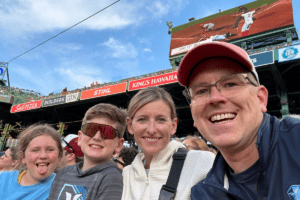I’ve spent much of my life as an amateur athlete—competing in club sports, marathons, triathlons, and century rides. Staying active isn’t just about my physical health; it’s a core part of who I am. Achieving my goals has always meant listening to and trusting my body.
I take great pride in my discipline and focus, but Charcot-Marie-Tooth disease (CMT) threatens to take it all away.
Imagine if the things you love most were slowly, inevitably stripped from you. If you could no longer use your hands, you’d have to stop playing the piano, stop cooking, stop painting, even stop dressing yourself. That’s the reality of CMT—a degenerative and progressive disease that worsens a little each day. And with that comes the constant fear of what tomorrow may bring.
I knew CMT ran in my family. My grandmother’s feet deformed so severely over the years that, by the time she passed, she could no longer walk properly. She also suffered from severe digestive issues, making her final years incredibly difficult. Of her seven children, four were diagnosed with CMT, my father being one of them.
My father’s CMT-related neuropathy became undeniable when he burned his leg on an open oven door and didn’t feel a thing. Today, even in retirement, he remains active—not because it’s a choice, but because exercise is his prescription for staying mobile as long as possible.
You may have never heard of CMT, yet it’s the most common inherited neurological disorder and one of the most prevalent rare diseases worldwide, affecting an estimated 3 million people across all races and backgrounds. It was first identified in 1886 by three doctors—Charcot, Marie, and Tooth—but in all those years, not a single FDA-approved treatment has been developed.
CMT affects the peripheral nerves, which carry signals from the brain to the muscles in the arms, legs, and limbs. As these nerves deteriorate, they cause muscle weakness, loss of coordination, and foot and leg deformities. The disease progresses at different rates for each person, but its impact lasts a lifetime. Those with CMT endure chronic pain, emotional distress, and the stigma of living with an invisible yet debilitating condition.
 For 40 years, my CMT progressed slowly enough that I remained physically active. When I started experiencing ankle sprains, joint pain, and repeated injuries—hyperextending my knee, straining my lower back—I blamed overtraining.
For 40 years, my CMT progressed slowly enough that I remained physically active. When I started experiencing ankle sprains, joint pain, and repeated injuries—hyperextending my knee, straining my lower back—I blamed overtraining.
Then the clumsiness set in. I stumbled more, lost my balance, tripped over rugs, and bumped into furniture I had navigated my entire life. I was losing awareness of where my body was in space. This sudden shift in my baseline filled me with fear—fear for my health, my mobility, and my future.
Joining the CMT Research Foundation (CMTRF) forced me to confront the reality of my condition. I had long known CMT was in my family. I understood it was genetic. I recognized the symptoms in myself. But it wasn’t until five months ago—through genetic testing at the University of Pennsylvania—that I received a definitive diagnosis: a rare form of CMT, type 2W.
For many patients, a correct diagnosis takes years because CMT symptoms overlap with other degenerative diseases like Multiple Sclerosis. Finding a cure is particularly challenging because CMT is a disease of the nerves, caused by defective genes. But gene therapy and other breakthrough treatments are finally coming into focus.
At CMTRF, finding a cure is our singular mission—but we can’t do it alone. We need your help to raise awareness. Here’s why it matters:
10 Reasons to Raise Awareness for CMT
- Early Diagnosis – Awareness leads to earlier diagnoses, allowing individuals to access medical care and interventions that can improve their quality of life.
- Education & Understanding – Many, including healthcare professionals, are unfamiliar with CMT. Educating the public, doctors, and policymakers is crucial.
- Research Funding – Increased awareness attracts funding for research, accelerating the development of treatments and, ultimately, a cure.
- Patient & Family Support – Awareness builds community, offering emotional and practical support for those living with CMT.
- Accurate Information – Websites like CMTRF.org provide up-to-date information on symptoms, diagnosis, treatments, and ongoing research.
- Community Engagement – Bringing people together to share experiences fosters solidarity and drives advocacy efforts.
- Better Healthcare Training – When doctors and therapists understand CMT, patients receive more accurate diagnoses and better care.
- Fundraising for Research – Awareness fuels donations and events that directly support critical scientific advancements.
- Policy & Advocacy Impact – Raising CMT’s profile encourages policymakers and healthcare organizations to prioritize funding and resources.
- Collaboration & Innovation – Conferences and summits bring together researchers, medical professionals, and patients, driving innovation in treatment development.
If you or a loved one has CMT—or you suspect your symptoms might be linked to CMT—please visit cmtrf.org. Learn about the 135+ subtypes of CMT, the varying degrees of symptoms, and the groundbreaking research CMTRF is funding to develop treatments and, ultimately, a cure.
Together, we can make CMT history.
About the Author

Not only is Laura MacNeill living with Charcot-Marie-Tooth, but she is also the CEO of the Charcot-Marie-Tooth Research Foundation (CMTRF). She and her husband have two children and live in Pennsylvania. Please read her full bio here.







